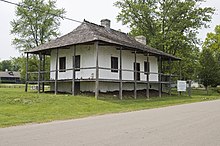
Several relatively distinct regional styles of colonial architecture are recognized in the United States. Building styles in the 13 colonies were influenced by techniques and styles from England, as well as traditions brought by settlers from other parts of Europe. In New England, 17th-century colonial houses were built primarily from wood, following styles found in the southeastern counties of England. Saltbox style homes and Cape Cod style homes were some of the simplest of homes constructed in the New England colonies. The Saltbox homes known for their steep roof among the back the house made for easy construction among colonists. The Cape Cod style homes were a common home in the early 17th of New England colonists, these homes featured a simple, rectangular shape commonly used by colonists. Dutch Colonial structures, built primarily in the Hudson River Valley, Long Island, and northern New Jersey, reflected construction styles from Holland and Flanders and used stone and brick more extensively than buildings in New England. In Maryland, Virginia, and the Carolinas, a style called "Southern Colonial" is recognized, characterized by the hall and parlor and central-passage house types, which often had large chimneys projecting from the gable-ends of the house. In the Delaware Valley, Swedish colonial settlers introduced the log cabin to America. A style sometimes called Pennsylvania colonial appeared later (after 1681) and incorporates Georgian architectural influences. A Pennsylvania Dutch style is recognized in parts of southeastern Pennsylvania that were settled by German immigrants in the 18th century.
Early buildings in some other areas of the United States reflect the architectural traditions of the colonial powers that controlled these regions. The architectural style of Louisiana is identified as French colonial, while the Spanish colonial style evokes Renaissance and Baroque styles of Spain and Mexico; in the United States it is found in Florida, Louisiana, New Mexico, Texas, Arizona, and California.
First Period is a designation given to building styles used in the earliest English settlements at Jamestown, Virginia (1607) and Plymouth, Massachusetts (1620) and later in the other British colonies along the Eastern seaboard.
These buildings typically included as steep roofs, small casement leaded glass windows (usually due to a scarcity of glass in the colonies), rich ornamentation (in the more expensive house only) and a massive central chimney.
French Colonial

- Bequette–Ribault House in Ste. Geneviève, Missouri, built 1778, French colonial
Developed in French-settled areas of North America beginning with the founding of Quebec in 1608 and New Orleans, Louisiana in 1718, as well as along the Mississippi River valley to Missouri.
The early French Colonial house type of the Mississippi River Valley region was the poteaux-en-terre, constructed of heavy upright cedar logs set vertically into the ground. These basic houses featured double-pitched hipped roofs and were surrounded by porches (galleries) to handle the hot summer climate.
By 1770, the basic French Colonial house form evolved into the briquette-entre-poteaux (small bricks between posts) style familiar in the historic areas of New Orleans and other areas. These homes featured double-louvred doors, flared hip roofs, dormers, and shutters.
Spanish Colonial

Gonzalez–Alvarez House, St. Augustine, Florida, built 1723, Spanish colonial
Developed with the earlier Spanish settlements in the Caribbean and Mexico, the Spanish Colonial style in the United States can be traced back to St. Augustine, Florida, the oldest established city in the country, founded in 1565. The early type of dwelling in Spanish Florida was the "board house", a small one-room cottage constructed of pit-sawn softwood boards, typically with a thatched roof. During the 18th century, the "common houses" were whitewashed in lime mortar with an oyster shell aggregate. Typically two-story, the houses included cooling porches to accommodate the Florida climate.
The style developed in the Southwest with Pueblo design influences from the indigenous Puebloan peoples architecture.
In Alta California, present-day California, the style developed differently, being too far for imported building materials and without skilled builders, into a strong simple version for building the missions between 1769 and 1823. Ranchos were typically built of adobe.
Dutch Colonial

No comments:
Post a Comment